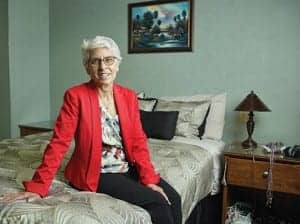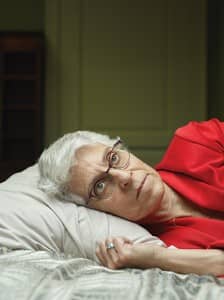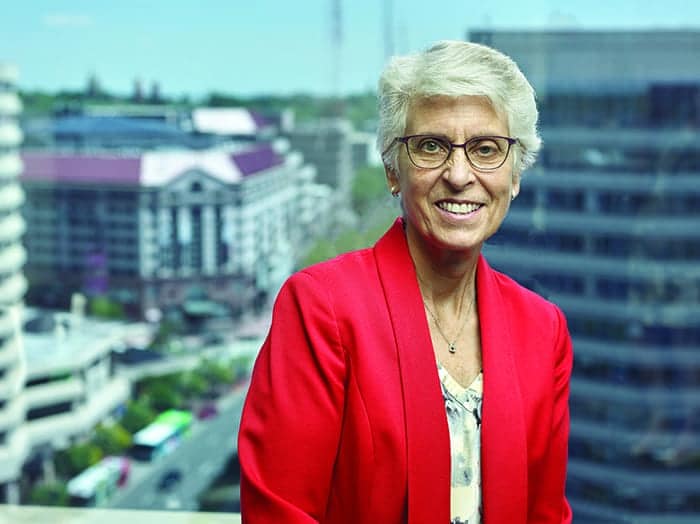Helene A. Emsellem, MD, becomes NSF chairperson—and expects its latest consensus project to answer questions on how much bed and wake time variation matters.
Neurologist and sleep specialist Helene A. Emsellem, MD, is the new chairperson of the National Sleep Foundation (NSF), effective July 1, 2018. But her involvement with the NSF goes back many more years.
The director of The Center for Sleep & Wake Disorders in Chevy Chase, Md, has been involved with the NSF as a volunteer since it opened its first Washington, DC-area offices 25 years ago. She has been on the NSF board for 8 years, most recently serving as vice chair. “I firmly believe in the NSF mission of sleep education and advocacy and am proud to spend my time in pursuit of these objectives,” she says.
Because Emsellem is local to the NSF’s Arlington, Va, office, she regularly attends its educational activities, as do her staff members. “As a local sleep lab, my offices have also had the dubious distinction of appearing frequently in sleep-related videos (B-roll) that involved NSF and various networks. It is still strange to see your own lab appear in news stories,” she says.

Since Emsellem’s sleep lab is geographically close to the NSF’s headquarters, occasionally consumer news stories about sleep health will feature images of videos from her sleep study rooms.
In this lightly edited interview with Sleep Review, Emsellem discusses her new role at the NSF as well as her expertise in sleep health.
Sleep Review (SR): How did you became a sleep specialist?
Helene A. Emsellem, MD: I am a neurologist by training with an abiding interest in understanding brain function and in teaching. My initial subspecialty was in electroencephalography and clinical neurophysiology; it was my position as the director of the electroencephalography laboratory at George Washington (GW) University, early in my academic career, that led to my interest in the monitoring of sleep and daytime alertness.
I was responsible for opening the first sleep laboratory at GW University Medical Center in the mid-1980s. Coming to sleep from a neurological background provides me with an interest in sleep that extends from the basic neurochemistry of sleep-wake pathways to the clinical manifestations of disturbances in sleep physiology. It has been particularly exciting to be involved in the evolving understanding of sleep science and the birth of sleep medicine as a specialty with multidisciplinary roots.
SR: The NSF’s Sleep Timing Consensus Panel will meet and publish recommendations about optimal timing and scheduling for sleep during your term as chairperson. Tell us about the NSF expert consensus projects.
Emsellem: NSF is committed to advancing sleep health, and understanding the timing of sleep from day to day and the degree of tolerable variability is extremely important. Telling the story of how sleep is essential to health for everyone means we have to take a general population approach to everything we do. The vast amount of sleep literature is about sleep disorders and not general (not disordered) populations. So we comb the literature, bring in the top people, and then engage in a very deliberative voting process.
Our sleep duration,1 quality,2 and satisfaction3 consensus reports have enjoyed very favorable receptions. This process helped us overhaul recommendations that had been around for many years and the sleep timing consensus panel recommendations will be an essential addition.
SR: What are the practical questions you hope the sleep timing project will answer?

Does a 30-minute difference in bed or wake time matter? That’s a question the NSF sleep timing project hopes to answer.
Emsellem: I hope the experts can agree on the degree of bed and wake time variation that is significant. Does a 30-minute difference matter? What about weekends? How big a price do we pay for “catch-up” sleep-ins and how much sleep loss can we realistically compensate for?
Parents want to know how strict they need to be in setting rules; our young adults in the workforce still like to stay up late on the weekends, and with workplace demands many working adults are challenged with insufficient sleep during the work week. Patients with inconsistent sleep-wake patterns are not necessarily difficult to diagnose, but the resolution takes time and commitment.
SR: Have any of the previous NSF published recommendations resulted in societal changes? Do you anticipate there will be societal changes based on NSF publishing recommendations on sleep timing?
Emsellem: Absolutely. The NSF work on sleep duration has had a major effect. We rarely see adults who are unaware of how much sleep they should be getting. They may not be getting the right amount of sleep, but they know how many hours of sleep NSF recommends.
The pediatric and adolescent population recommendations naturally require more categories, but I think that word has also reached parents.
I look forward to increased mindfulness about sleep timing on the part of our patients as a result of the sleep timing consensus panel’s work. With more scientific literature about the long-term risks of insufficient sleep, particularly on cognitive function, I believe that this information and guidance is desired and “timely.”
SR: NSF has partnered with Elsevier to create a textbook. Why do we need a textbook?
Emsellem: Foundations of Sleep Health is a textbook for graduate school public health students, nurses, and related health care professionals. We were disappointed to find that schools of public health don’t have any coursework related to sleep, so we are going to change that.
It will be interesting for other health professionals, but we focused on public health professionals. Part of what will make this book special is that we are fully committed to developing all the materials within the public health pedagogy. The textbook is scheduled to publish in June 2019.
SR: You wrote Snooze…or Lose!: 10 “No War” Ways to Improve Your Teens Sleep Habits, which first published in 2006. Is the teen sleep problem getting better or worse?
Emsellem: Education and awareness are the beginning of behavioral and societal change. I wrote the book to help parents understand the challenges teens face in getting adequate sleep, the science behind the changes in biology associated with puberty, and the reason that early school start times make life so difficult for teens (and their parents). My goal was to provide parents with a resource, written in lay terms, to fight an entrenched bureaucracy of early high school start times and begin the slow process of change.
The old concept that obstinate defiant behavior is a rite of passage of the teenage years is now balanced by the observation that teens require 8 to 10 hours of sleep per night and that well rested teens can be remarkably pleasant, while still asserting their independence.
Newer information about the impact of light on sleep and studies of the negative impact of over-scheduling our children augment the basic information in Snooze…or Lose!
Somewhat surprisingly, many of the high achieving teens I now see for daytime tiredness and insufficient sleep duration have self-imposed overly rigorous schedules and commitments, driven by their own competitiveness and what I believe are misplaced concerns regarding college admissions. Continued attention to adequate teen sleep is critical to the health and well-being of our children.
SR: The 2017 Nobel Prize in Physiology or Medicine was awarded to 3 circadian biology researchers and it has been an expanding area of interest for many researchers. What is your view on the impact of this recognition?
Emsellem: The international recognition of circadian biology and the elucidation of the genetic control of sleep timing with the award of the 2017 Nobel Prize in Physiology or Medicine to 3 circadian scientists have truly helped draw attention to the complexities of sleep-wake timing and the challenges that we all face in getting adequate sleep time in our 24/7 “lit” world.
I do not believe that there is a single sleep patient, regardless of the underlying diagnosis, who does not benefit from an understanding of the circadian influences on sleep. Circadian misalignment is not only an independent issue for the expanding number of individuals challenged with working non-traditional shifts but becomes a coexistent problem in patients with sleep-onset insomnia and other sleep disorders.
In my practice of sleep medicine, in the sleep-challenged city of Washington, DC, patients are routinely educated regarding the influence and timing of light exposure, especially blue light, on alertness. I find that patients are intrigued by the neurobiology of the retino-hypothalamic pathway and excited to take control of light exposure by purchasing inexpensive orange lens glasses to protect themselves from the alerting impact of blue light and to use the apps available on our smartphones and computers to control these influences.
Sree Roy is editor of Sleep Review.
References
1. Hirshkowitz M, Whiton K, Albert SM, et al. National Sleep Foundation’s updated sleep duration recommendations: final report. Sleep Health. 2015 Dec;1(4):233-43.
2. Ohayon M, Wickwire EM, Hirshkowitz M, et al. National Sleep Foundation’s sleep quality recommendations: first report. Sleep Health. 2017 Feb;3(1):6-19.
3. Ohayon MM, Chen MC, Bixler E, et al. A provisional tool for the measurement of sleep satisfaction. Sleep Health. 2018 Feb;4(1):6-12.







Congratulations to Dr. Emsellem on her election to Board Chair at the National Sleep Foundation. Wishing her and the others in the leadership every success in their work advancing sleep health.